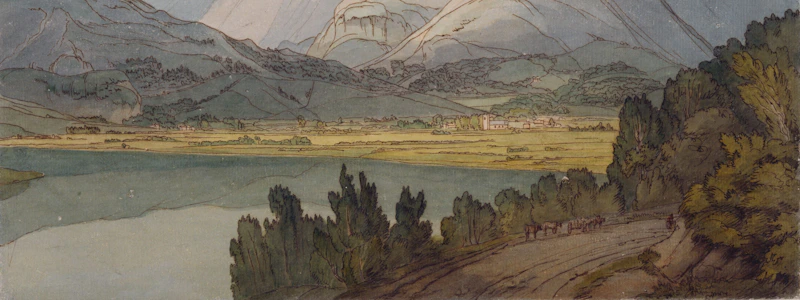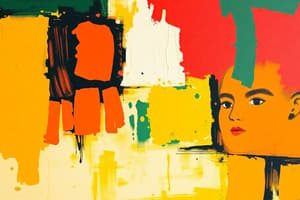Podcast
Questions and Answers
What is the primary purpose of the long eaves in the Bahay Kubo?
What is the primary purpose of the long eaves in the Bahay Kubo?
- To support the weight of the roof
- To create a sense of grandeur
- To provide additional living space
- To provide natural cooling (correct)
What is the main material used in constructing Folk Architecture in the Philippines?
What is the main material used in constructing Folk Architecture in the Philippines?
- Concrete
- Wood
- Bamboo (correct)
- Rock
What is the name of the ancient Filipino warships used for seasonal raids and sea battles?
What is the name of the ancient Filipino warships used for seasonal raids and sea battles?
- Karaka
- Bahay Kubo
- Karakoa (correct)
- Hagdan-Hagdang Palayan
What is the term for the visual flow of an artwork, creating an illusion of motion?
What is the term for the visual flow of an artwork, creating an illusion of motion?
What is the term for the distribution of visual weight to appear equal in balance?
What is the term for the distribution of visual weight to appear equal in balance?
What is the term for the arrangement of opposite elements and effects?
What is the term for the arrangement of opposite elements and effects?
Who is known as the 'Father of Filipino Painting'?
Who is known as the 'Father of Filipino Painting'?
During which period did the development of art stop in the Philippines?
During which period did the development of art stop in the Philippines?
Who painted the 'History of Manila' mural at the Manila City Hall?
Who painted the 'History of Manila' mural at the Manila City Hall?
What style of painting was Fabian Dela Rosa known for?
What style of painting was Fabian Dela Rosa known for?
When was the Academia de Dibujo y Pintura, the first school of drawing in the Philippines, founded?
When was the Academia de Dibujo y Pintura, the first school of drawing in the Philippines, founded?
What was the title of the painting by Vicente Alvarez Dizon in 1942?
What was the title of the painting by Vicente Alvarez Dizon in 1942?
What type of scripts have been used by various ethnolinguistic groups from pre-colonial times to the present?
What type of scripts have been used by various ethnolinguistic groups from pre-colonial times to the present?
What is the significance of folk writing in the Philippines?
What is the significance of folk writing in the Philippines?
Which ethnic group is known for their intricate and abundant use of accessories?
Which ethnic group is known for their intricate and abundant use of accessories?
What is the approximate age of pottery in the Philippines?
What is the approximate age of pottery in the Philippines?
What is the primary purpose of accessory making in the Philippines?
What is the primary purpose of accessory making in the Philippines?
What is another term for folk writing in the Philippines?
What is another term for folk writing in the Philippines?
What does the concept of Appropriation in Contemporary Art involve?
What does the concept of Appropriation in Contemporary Art involve?
What is the significance of Time in Contemporary Art?
What is the significance of Time in Contemporary Art?
What is Hybridity in Contemporary Art?
What is Hybridity in Contemporary Art?
What is the primary characteristic of Visual Arts?
What is the primary characteristic of Visual Arts?
What is the focus of Perspective in Contemporary Art?
What is the focus of Perspective in Contemporary Art?
What is the concept of Text in Contemporary Art?
What is the concept of Text in Contemporary Art?
What is the primary purpose of the Tongatong instrument?
What is the primary purpose of the Tongatong instrument?
What is the characteristic of the Solibao instrument?
What is the characteristic of the Solibao instrument?
What is the meaning of the Cariñosa dance?
What is the meaning of the Cariñosa dance?
What is the characteristic of the Kalaleng or Tongali instrument?
What is the characteristic of the Kalaleng or Tongali instrument?
What is the origin of the Pandanggo sa Ilaw dance?
What is the origin of the Pandanggo sa Ilaw dance?
What is the characteristic of the Tinikling dance?
What is the characteristic of the Tinikling dance?
Flashcards are hidden until you start studying
Study Notes
Filipino Art and Artists
- Damian Domingo, also known as "The First Great Filipino Painter," founded the Academia de Dibujo y Pintura, the first school of drawing in the Philippines (1821), and is considered the "Father of Filipino Painting."
- Fabian Dela Rosa (1869-1937) was a painter who excelled in realistic portraits, genre, and landscapes, and was enrolled at the Escuela de Bellas Artes y Dibujo, taking lessons from Lorenzo Guerrero.
- Carlos "Botong" Francisco (1913-1969) was an Angono-based painter who depicted Philippine history in his "History of Manila" mural at the Manila City Hall.
Traditional Art Forms in the Philippines
- Folk Architecture: Different types of folk architecture exist, made from materials like bamboo, wood, rock, coral, rattan, and grass, such as the Bahay Kubo, characterized by a tall, steep-pitched roof and long eaves.
- Maritime Transport: Includes boat houses, boat making, and maritime traditions, like the ancient Filipino warship Karakoa.
- Folk Literature: Encompasses epics, songs, and myths.
- Folk Writing: Includes indigenous scripts like hanunó'o/hanunoo, buhid/build, Tagbanwa, and palaw'an/pala'wan, used by various ethnolinguistic groups.
Elements and Principles of Contemporary Art
- Concept: A plan or intention and idea or invention in contemporary art.
- Appropriation: Creating a new work of art by taking pre-existing images from other sources and modifying or incorporating them with new ones.
- Time: The meaning of the work is dependent on the passing of time.
- Performance: Artwork created by or presented to an audience.
- Hybridity: Artists working with frontier areas of science and emerging technologies.
- Perspective: Artists working with the actual space surrounding the artwork itself.
- Destruction: Artists using methods to show damage in or to their artwork.
- Text: Contemporary artists utilizing text in their art to push past the concept that text is only meant to be read.
Musical Instruments of the Filipinos
- Flat Gong (Gangsa): Played by groups in the Cordillera region, struck by hands.
- Kalaleng or Tongali (Nose Flute): Air is forced through nostrils.
- Tongatong: A bamboo percussion instrument used to communicate with spirits during house blessings.
- Solibao: A drum constructed from a hollowed log capped with animal skin, played by striking the drum head using the palm of the hand.
Dances of the Filipinos
- Tinikling: A dance that uses bamboo poles.
- Cariñosa: A folk dance that depicts courtship and uses a fan and handkerchief.
- La Estudiantina: Originally performed by women carrying a book and a fan.
- Pandanggo sa Ilaw: A dance that originated from Mindoro, simulating fireflies at dusk and at night.
- Itik-Itik: A dance that originated from Surigao, imitating a duck.
Studying That Suits You
Use AI to generate personalized quizzes and flashcards to suit your learning preferences.




